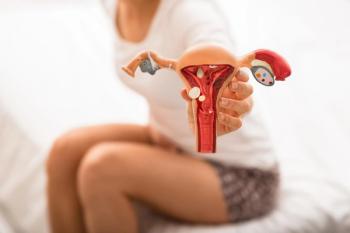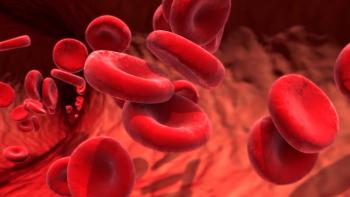
Treatment options for vulvar vestibulitis
Considering how successful surgery is, how do you tell a young woman who's unable to have intercourse that she needs to learn to live with her pain? Even so, a surgical approach is only for carefully selected women--usually those with primary vestibulitis who have exhausted other treatment options.
VULVAR VESTIBULITIS
Treatment options for vulvar vestibulitis
By Elizabeth Gunther Stewart, MD
Considering how successful surgery is, how do you tell a young woman who's unable to have intercourse that she needs to learn to live with her pain? Even so, a surgical approach is only for carefully selected womenusually those with primary vestibulitis who have exhausted other treatment options.
No, it's not all in her headand she doesn't have a urinary tract infection. A woman with vulvar vestibulitis (VVS) can't have normal sexual relations because it's just too painful. Sex hurts. Yet causes and clear definitions of vulvar pain remain elusive, making our efforts to understand itand help these patientsa work in progress.
We do know there are three clear-cut categories of vulvar pain. The firstpain of known causeincludes conditions like cyclic candidal vulvovaginitis, lichen planus, Bartholin abnormalities, and genital herpes. A second, unprovoked generalized vulvar dysesthesiaalso known as dysesthetic vulvodynia or essential vulvodyniais characterized by spontaneous burning, stinging, or rawness anywhere on the vulva.1 The third is the focus of this article: Provoked localized dysesthesiaalso known as vulvar vestibulitis (VVS), vestibular adenitis, or vestibulodyniarefers to pain on touch within the vestibule.1
VVS, the leading cause of dyspareunia in women under 50, can be primary or secondary.2 A woman with primary VVS experiences vestibular pain when she first starts using tampons, has a speculum inserted, or becomes sexually active. On the other hand, secondary VVS develops after a period of comfortable sexual relations. The epidemiology is unknown; preliminary data from almost 6,000 women in an ongoing NIH-funded survey of 16,000 women between ages 18 and 64 show that 16% reported a history of chronic burning, knife-like or sharp pain, or pain on contact that lasted for 3 months or longer.3
My goal here is to outline the criteria for diagnosing this condition and to discuss the basic pain management principles for VVS. I'll then discuss the often controversial surgical options available when medical therapy fails.
Does inflammation trigger nerve pain?
While casecontrol studies of VVS do not identify a single common risk factor, current theory suggests vulvar inflammation or trauma as a common denominator.4-6 The inflammatory event releases a cascade of cytokines that sensitizes nociceptors in the nerve fibers supplying the unique vestibular epithelium. The prolonged neuronal firing, in turn, sensitizes the wide-dynamic-range neurons in the dorsal horn, making them respond abnormally, and transforming the sensation of touch in the vestibule into pain (allodynia).7
With this theory, the initiating event may vary: recurrent Candida for some, treatment for the human papillomavirus (HPV) for others, sustained micro-trauma during adolescent sexual experience for still others. But the end result of pain on vestibular touch is the same. Casecontrol studies have shown that women with VVS have a significantly increased number of intraepithelial nerve endings.8,9 Researchers confirmed that these nerve endings are in fact nociceptors, by identifying through neurochemical means just one peptidecalcitonin gene-related peptidewhich is known to exist in nociceptive afferent nerves.10
Until the last decade, experts thought genital pain and dyspareunia were psychosexual in origin.11 Despite the clinical impression that psychological factors might play a role in VVS, evidence is lacking for a psychological cause.2,12 Psychological factors cannot explain the striking sensory abnormalities researchers have uncovered in women with VVS: lowered pain thresholds, increased sensitivity to heat, cold, vibration, and distention.13 Moreover, investigators have not found that women with VVS are more likely to have been victims of sexual abuse or assault.14
Diagnosing primary and secondary VVS
A patient's history is key in diagnosing VVS pain. In primary disease, look for pain upon her first tampon use, speculum examination, or intercourse. For secondary VVS, on the other hand, it's more common for patients to report ongoing irritationinaccurately attributed to urinary tract infection, candidal or other vaginitisfollowed by dyspareunia. Often clinicians inaccurately assume that women with irritation and dyspareunia from VVS have various infections. That leads them to frequently treat patients for asymptomatic colonization with group B streptococcus or bacterial vaginosis (which does not cause dyspareunia).
For physical examination, Friedrich's criteria are the accepted standard for diagnosis: (1) severe pain on vestibular touch or attempted vaginal entry; (2) tenderness localized within the vestibule; and (3) physical findings of erythema of various degrees. You must carefully inspect the area to rule out known causes of vulvar pain: vulvovaginitis, lesions, dermatitis, and dermatosis. Vestibulitis can masquerade as the tender inflamed epithelium caused by Candida or desquamative inflammatory vaginitis or the glassy erythematous erosions of lichen planus.
The Q-tip test, eliciting tenderness with a cotton-tipped applicator around the "clock face" of the vestibule, is the sine qua non (Figure 1). An overzealous clinician eager to complete a speculum examination can easily miss such tenderness by failing to evaluate the vestibule carefully.
Explore all the medical options first
No matter what causes VVS, women who suffer from the disorder must cope with both the pain and stress of the psychological, sexual, and relationship fallout that results from genital pain that precludes normal sexual relations. Clinicians caring for women with VVS need to adopt a comprehensive approach to treatment: Give a clear diagnosis. Provide education and support. Treat the pain. And make referrals for physical therapy, biofeedback, and individual or couples counseling, and/or sexual therapy.
In the absence of clear pathophysiology, as many as 26 treatments for VVS have evolved over the years.15 Data on their efficacy are limited to a few open clinical trials and small placebo-controlled studies. Nevertheless, the basic pain management principles for VVS begin with medical therapy, followed by surgery if no progress is made. While secondary VVS usually responds well to medical management, primary VVS is far more difficult to treat and often results in a discussion about surgery.
Education and support. Patients who've been struggling with this pain syndrome are very relieved when you give them a clear diagnosis and explanation. Learning that their problem is not malignant or sexually transmitted reassures these women and they're pleased to find out that VVS won't make them infertile. Among the excellent educational materials available are patient information sheets that you can copy from a clinical atlas.16 A lay text on vulvodynia came out in 2002 and my own book for women on vulvovaginal health and disease includes complete coverage of pain and sexual functioning.17-18 In addition, the National Vulvodynia Association provides education and support through their Web site
It's important from the start to discuss with a patient the problem's impact on her life and her relationship and to offer appropriate counseling or support. If she experiences depression, which is a common response to the pain and its sequelae, be sure to address that issue.19 Also, emphasize how important it is for the patient to discuss the pain with her partner and to advocate alternatives to vaginal sex until the benefits of therapy emerge.
Hygiene and comfort measures. Eliminating all possible irritants is an important step. If patients are using topical creams with an irritating baseas is often the casethey need to discontinue them. Many lubricants also contain irritants as preservatives. A dab of pure vegetable oil in the vestibule and on the partner works well, although oil and condoms don't mix. Advise women to wear loose white underwear, cleanse gently, and to avoid contact with scented products. The daily use of a potentially irritating mini-pad or panty-liner is not healthy for any woman. Sitz baths in comfortable water are soothing; crushed ice in a small plastic zip-top bag helps relieve flare-ups of pain. If dryness is contributing to the discomfort, topical petroleum jelly or nonirritating and nonsensitizing, ointments such as Aquaphor in a very thin film can help. Or if spontaneous burning or rawness are present in the vestibule, 2% topical lidocaine jelly may bring relief. When a patient is ready to resume intercourse, she may benefit from topical 5% lidocaine ointment to the vestibule 15 minutes before sexual activity, although this burns briefly on application. Ice and more lidocaine also help for postcoital discomfort.
Eliminating potential triggers. If you suspect Candida albicans or it has been a factor, suppression for 3 to 6 months with a weekly oral dose of 150 mg fluconazole is important. In addressing the pain, antifungal therapy alone won't help, but it will control a possible inflammatory trigger. You must consider the interaction with other medications that influence the cytochrome P 450 system (like statins). In addition, be sure to adequately treat dermatosis, such as lichen sclerosus or lichen planus.
Topical estrogen. Although many women apply topical estrogen to the vestibule, it hasn't been studied. It may help by improving epithelial maturation, or through a possible immune function: higher levels of estradiol inhibit production of the inflammatory cytokine interleukin-1.20 Applying 1/4 teaspoon of estrogen cream nightly to the vestibule is soothing, lubricating, and possibly therapeutic.
Oxalate. One case report suggests that reducing high urinary oxalate can offer some relief, and can be successfully treated with a low oxalate diet and 1,200 mg calcium citrate daily to bind the oxalate.21 A casecontrol study showed that patients with vulvar pain don't have higher oxalate levels, however, and it failed to show a correlation between oxalate level and reduction in the pain.22 Although this regimen requires at least 6 months to have an effect, anecdotally, many women report that it relieves their pain, and it seems to empower women. Information about the diet can be obtained from The Vulvar Pain Foundation at
Tricyclics. Unrelated to their antidepressant action, tricyclics are widely used to treat chronic pain.23 In fact, they've become the mainstay of treatment for women with generalized dysethesia.24 Tricyclics also improved pain for 89/230 women with VVS in a prospective study.25 In addition, a large double-blind, placebo-controlled study is currently in progress.
The tricyclics amitriptyline (Elavil), desipramine (Norpramin), and nortriptyline (Aventyl, Pamelor) are given as 10-mg tablets at bedtime, and increased slowly every 5 to 7 days to a dosage that controls symptoms (usually 100 to 150 mg). Since amitriptyline is so sedating, have your patient start with half a 10-mg tablet. Sedation is often transient and can be managed by a slower increase (every 10 days) or giving the dose earlier in the evening. Desipramine and nortriptyline are less sedating than amitriptyline; imipramine is the least sedating, and, in fact, is often taken in the morning since it can cause insomnia. If one tricyclic is not helpful, try another member of the family. Be sure to educate the patient about side effects and support her in coping with them, because anxiety and "nervousness" can lead her to discontinue their use. Because constipation can be a major problem, advise patients to watch for this and, if it does arise, to add a daily fiber supplement. Also, educate the patient about dry mouth and eyes, palpitations, sun sensitivity, and increased appetite that can lead to weight gain.
A study of desipramine, 150 mg daily, combined with topical 5% lidocaine ointment applied five to six times daily to the vestibule showed promising results, with 71% of 53 patients completely free of symptoms.26 Frequent use of the topical anesthetic may prevent repetitive afferent nociceptor input to the CNS and provide an anti-inflammatory effect in the vestibular mucosa.
Other medications, including anticonvulsants, selective serotonin reuptake inhibitors (SSRIs), and venlafaxine are being tried but the jury is still out as to their efficacy.
Corticosteroids. While some reports suggest that medium- to high-potency corticosteroids can help in some cases, results are unpredictable and most attempts disappointing.27,28 The low expression of cyclooxygenase 2 and inducible nitric oxide synthase in the vestibular mucosa of women with VVS suggests that traditional inflammation is not present and corticosteroid treatment may be unfounded.29 Unless there is evidence of dermatitis or dermatosis, I do not suggest using them.
Interferon. Injecting interferon into the vestibule became popular in the 1980s when HPV was thought to cause VVS. However, a role for HPV in VVS has never been proved.30 There have been a total of eight studies using interferon either systemically or injecting it locally into the vestibule. The most common protocol consists of IFN-alpha, 1 million units injected circumferentially around the vestibule three times a week for 4 weeks. Despite short-term success in some cases, long-term follow-up studies have been disappointing. Results of the longest one showed that only 21% of 19 women remained in full remission after 3 years.31 A recent single-center review showed that interferon produces demonstrable improvement in 43%, slightly better than placebo.32 I have worked extensively with IFN for more than 5 years without observing any lasting improvement for any patient.
Physical therapy and biofeedback. Women with VVS frequently report pelvic floor muscle dysfunction with elevated resting muscle tension, which they can successfully overcome with biofeedback.33 Physical therapy with pelvic floor exercise, myofascial release and trigger-point pressure, and massage may help the abnormalities of the pelvic floor by reducing tension and spasm in the muscles, and also address musculoskeletal abnormalities (for example, the inflammation of the sacroiliac joints that may worsen VVS symptoms).34 Advise patients seeking a physical therapist who's familiar with the pelvic floor to call The American Physical Therapy Association 800-999-APTA and to select "Women's Health" from the menu selections. A regional representative can help them locate a therapist in their area. Or they can visit their Web site at
Surgery may be controversial but it's effective
Surgical approaches to VVS have been criticized for several reasons. But as an explanation based on the nociceptive pain mechanism seems to be rapidly clearing up the mystery of what causes this pain, a new focus of treatment emerges. This theory suggests that therapy should concentrate on the periphery, with removal of the affected mucosa, including the peripheral part of the primary afferent neuron.13 True, surgery is often not the approach used for other types of pain; we don't, for example, treat glossodynia by excising the tongue. But the difference is, surgery is recommended for patients with pain limited to the vestibule, because VVS is thought to represent nociceptive and not neurogenic pain, as in glossodynia. Patients who have generalized dysesthesia are inappropriate candidates for surgerybut then they do not have vestibulitis"
Some critics decry surgery as "mutilating," when in fact removal of the vestibule (vestibulectomy) represents superficial excision of just a few millimeters of epitheliuma minute area discernible only to a trained eye. If vaginal advancement is performed, patients typically comment after surgery that the perineum looks "different, but satisfactory."35
With the significant success rates of surgery, it is difficult to tell a young woman who is unable to have intercourse that she needs to learn to live with her pain. If she has not responded to careful localized care with elimination of irritants, a trial of centrally acting drugs, physical therapy with biofeedback, individual psychosexual therapy and support, and alternative treatments, her options are dismal.
Many surgical procedures exist, including focal excision, vestibuloplasty of various types: excision of a localized painful area such as the anterior vestibule, the posterior vestibule, or the lateral vestibule without vaginal advancement. A version of vestibuloplasty that denervates the vestibule with incision, undercutting, and closure of the mucosa without excising the painful tissue or increasing the caliber of the introitus has been completely unsuccessful.36
Vestibulectomy excises the vestibule with vaginal advancement. The surgeon excises a U-shaped area of the vestibule from 5 mm lateral to the urethra to the posterior fourchette. The hymenal ring is included. The margins of the vestibule are reapproximated to the vaginal wall (Figure 2). To cover that excised area posteriorly, a piece of posterior vaginal wall is dissected from the underlying tissue.
Perineoplasty involves excision of the vestibule with vaginal advancement overlying a portion of excised perineum. The U-shaped excision includes the hymeneal ring and vestibule. Through a U-shaped perineal incision, the vagina is mobilized and the vaginal mucosa is undermined for an additional 1 to 2 cm and advanced to cover the perineal defect.
Surgical success rates range from 40% to 100%, with success defined as much improved or completely cured. Large variations exist, however. Factors that limit direct comparison are differences in numbers of patients, presence of associated symptoms like urinary tract symptoms, other medical treatment at the time of surgery, technique used, definition of success, and length of follow-up. Nevertheless, the 70% average success rate of surgery makes it an important option for this debilitating condition. But first and foremost, patient selection is crucial. Pain must be confined to the vestibule and existing vaginismus must be treated.37 In addition, preoperative sexual therapy to deal with learned pain will improve operative response.38
A surgical approach was successful in a randomized clinical trial that compared three treatments for VVS: cognitive-behavioral therapy, surface electromyographic biofeedback, and vestibulectomy (perineoplasty).39 All treatment groups reported significant reductions in pain measured at posttreatment and 6-month follow-up. The surgical group, however, had significantly better outcome measures of pain reduction and improved sexual functioning than the other two groups.
EDITOR'S NOTE:
Dr. Stewart and co-author Paula Spencer have written a book on vulvovaginal health and disease, The V Book: A Doctor's Guide to Complete Vulvovaginal Health (New York, Bantam, 2002), which includes chapters on pain and sexual functioning in the presence of pain. It contains some 500 clinical references from medical journals. More information is available on her Web site,
REFERENCES
1. Proceedings of the XVth World Congress, International Society for the Study of Vulvovaginal Disease, Santa Fe, New Mexico, September 26-30, 1999.
2. Meana M, Binik YM, Khalife S, et al. Biopsychosocial profile of women with dyspareunia. Obstet Gynecol. 1997;90:583-589.
3. Harlow BL, Stewart EG. A population-based assessment of chronic unexplained vulvar pain: have we underestimated the prevalence of vulvodynia? J Am Med Womens Assoc. 2003 Spring;58:82-88.
4. Mann MS, Kaufmann RH, Brown D Jr, et al. Vulvar vestibulitis: significant clinical variables and treatment outcome. Obstet Gynecol. 1992;79:122-125.
5. Bazin S, Bouchard C, Brisson J, et al. Vulvar vestibulitis syndrome: an exploratory case-control study. Obstet Gynecol. 1994;83:47-50.
6. Foster DC. Case control study of vulvar vestibulitis. J Womens Health. 1995;6:677-680.
7. Bornstein J, Shapiro S, Goldshmid N, et al. Severe vulvar vestibulitis. Relation to HPV infection. J Reprod Med. 1997;42:514-518.
8. Westrom LV, Willen R. Vestibular nerve fiber proliferation in vulvar vestibulitis syndrome. Obstet Gynecol. 1998;91:571-576.
9. Bohm-Starke N, Hilliges M, Falconer C, et al. Increased epithelial innervation in women with vulvar vestibulitis syndrome. Gynecol Obstet Invest. 1998;46:256-260.
10. Bohm-Starke N, Hilliges M, Falconer C, et al. Neurochemical characterization of the vestibular nerves in women with vulvar vestibulitis syndrome. Gynecol Obstet Invest. 1999;48:270-275.
11. Steege JF, Ling FW. Dyspareunia. A special type of chronic pelvic pain. Obstet Gynecol Clin North Am. 1993;20:779-793.
12. Bergeron S, Binik YM, Khalife S, et al. The treatment of vulvar vestibulitis syndrome: towards a multimodal approach. J Sex Marital Ther. 1997;12:305-311.
13. Bohm-Starke N, Hilliges M, Brodda-Jansen G, et al. Psychophysical evidence of nociceptor sensitization in vulvar vestibulitis syndrome. Pain. 2001;94:177-183.
14. Dalton VK, Haefner HK, Reed BD, et al. Victimization in patients with vulvar dysthesia/vestibulodynia. Is there an increased prevalence? J Reprod Med. 200147:829-834.
15. Rosenman SD. Vulvar vestibulitis: a reappraisal. Conn Med. 2002;66:589-593.
16. Black MM, McKay M, Braude PR, et al. Obstetrics and Gynecologic Dermatology. 2nd ed. London: Mosby International Limited; 2002:230-231.
17. Glazer HI, Rodke G. The Vulvodynia Survival Guide: How to overcome painful vaginal symptoms and enjoy an active lifestyle. Oakland, Ca: New Harbinger Publications; 2002.
18. Stewart EF, Spencer P. V Book: A Doctor's Guide to Complete Vulvovaginal Health. New York, NY: Bantam; 2002.
19. Bodden-Heidrich R, Kuppers V, Beckmann MW, et al. Psychosomatic aspects of vulvodynia. Comparison with the chronic pelvic pain syndrome. J Reprod Med. 1999;44:411-416.
20. Cutolo M, Sulli A, Seriolo B, et al. Estrogens, the immune response and autoimmunity. Clin Exp Rheumatol. 1995;13:217-226.
21. Solomons CC, Melmed MH, Heitler SM. Calcium citrate for vulvar vestibulitis: a case report. J Reprod Med. 1991;36:879-882.
22. Baggish MS, Sze EH, Johnson R. Urinary oxalate secretion and its role in vulvar pain syndrome. Am J Obstet Gynecol. 1997;177:507-511.
23. Davar G, Maciewicz RJ. Deafferentation pain syndromes. Neurol Clin. 1989;7:289-304.
24. McKay M. Dysesthetic ("essential") vulvodynia. Treatment with amitriptyline. J Reprod Med. 1993;38: 9-13.
25. Pagano R. Vulvar vestibulitis syndrome: an often unrecognized cause of dyspareunia. Aust N Z J Obstet Gynaecol. 1999;39:79-83.
26. Foster DC, Duguid KM. Open label study of oral amitriptyline and topical lidocaine for the treatment of vulvar vestibulitis. Abstract, International Conference on Mechanism and Treatment of Neuropathic Pain. Rochester, NY, 1998.
27. Murina F, Tassan P, Roberti P, et al. Treatment of vulvar vestibulitis with submucous infiltrations of methylprednisolone and lidocaine. An alternative approach. J Reprod Med. 2001;46:713-716.
28. Nunns D. Vulval pain syndromes. BJOG. 2000; 107;1185-1193.
29. Bohm-Starke N, Falconer C, Rylander E, et al. The expression of cyclooxygenase 2 and inducible nitric oxide synthase indicates no active inflammation in vulvar vestibulitis. Acta Obstet Gynecol Scand. 2001;80:638-644.
30. Baggish MS, Mikos JR. Vulvar pain syndrome: a review. Obstet Gynecol Surv. 1995;50:618-627.
31. Bornstein J, Pascal B, Abramovici H. Long-term follow-up of patients treated for severe vulvar vestibulitis by intramuscular interferon beta. Isr J Obstet Gynecol. 1994;5:146-148.
32. Hurtado SM, Treene LD, Marinoff SC. Effectiveness of interferon therapy for the treatment of vulvar vestibulitis. International Society for the Study of Vulvovaginal Disease, XVth World Congress, Santa Fe, New Mexico, 1999.
33. Glazer HI, Rodke G, Swencionis C, et al. Treatment of vulvar vestibulitis syndrome with electromyographic biofeedback of pelvic floor musculature. J Reprod Med. 1995;40:283-290.
34. Hartmann EH, Nelson C. The perceived effectiveness of physical therapy treatment on women complaining of chronic vulvar pain and diagnosed with either vulvar vestibulitis syndrome or dysesthetic vulvodynia. J Section Women's Health. 2001;25:13-18.
35. Foster DC, Butts C, Woodruff JD. Long-term outcome of perineoplasty for vulvar vestibulitis. J Womens Health. 1995;4:669-675.
36. Bornstein J, Zarfati D, Goldik Z, et al. Perineoplasty compared with vestibuloplasty for severe vulvar vestibulitis. Br J Obstet Gynaecol. 1995;102:652-655.
37. Abramov L, Wolman I, David MP. Vaginismus: an important factor in the evaluation and management of vulvar vestibulitis syndrome. Gynecol Obstet Invest. 1994;38:194-197.
38. Schover LR, Youngs DD, Cannata R. Psychosexual aspects of the evaluation and management of vulvar vestibulitis Am J Obstet Gynecol. 1992;167:630-636.
39. Bergeron S, Binik YM, Khalife S, et al. A randomized comparison of group cognitive-behavioral therapy, surface electromyographic biofeedback, and vestibulectomy in the treatment of dyspareunia resulting from vulvar vestibulitis. Pain. 2001;91:297-306.
Dr. Stewart is Director, Stewart-Forbes Vulvovaginal Service, Harvard Vanguard Medical Associates, Boston, Mass., and Assistant Professor of Obstetrics and Gynecology, Harvard Medical School, Boston, Mass.
Key points
- Vulvar vestibulitisthe leading cause of painful coitus in women under 50is distinct from pain that has a recognized cause, like cyclic candidal vulvovaginitis or lichen planus, and unprovoked generalized vulvar dysesthesia.
- Friedrich's criteria are the accepted standard for diagnosing VVS: severe pain on vestibular touch or attempted vaginal entry; tenderness localized within the vestibule; and physical findings of erythema of various degrees.
- Treatment includes: (1) education, support, and referrals; (2) elimination of irritants, comfort measures; (3) 1/4 tsp of topical estrogen cream applied to the vestibule daily; (4) topical lidocaine to the vestibule, 1/4 tsp five to six times daily; (5) tricyclic antidepressant nortriptyline or desipramine 150 mg at bedtime; and (6) physical therapy to the pelvic floor with biofeedback.
- Despite criticism of surgical procedures for VVS, the 70% surgical success rate makes it an important option for carefully selected women with pain limited to the vestibule who have not responded to other therapy.
Elizabeth Stewart. Treatment options for vulvar vestibulitis. Contemporary Ob/Gyn Oct. 1, 2003;48:47-61.
Newsletter
Get the latest clinical updates, case studies, and expert commentary in obstetric and gynecologic care. Sign up now to stay informed.










